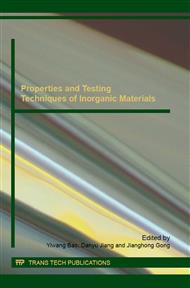[1]
Cyr M, Carles-Gibergues A, Tagnit-Hamou A. Titanium fume and ilmenite fines characterization for their use in cement-based materials. Cement and concrete research, 2000, 30(7): 1097-1104.
DOI: 10.1016/s0008-8846(00)00290-8
Google Scholar
[2]
Rai A, Prabakar J, Raju C B, et al. Metallurgical slag as a component in blended cement. Construction and Building Materials, 2002, 16(8): 489-494.
DOI: 10.1016/s0950-0618(02)00046-6
Google Scholar
[3]
B. Chenguang, C. Yan, P. Henian. The Study of the Physical Properties of BF Slag Containing High Titania in Neural Condition. 60th Ironmaking Conference Proceedings. USA. 2001. 3, P: 887~892.
Google Scholar
[4]
Chenguang Bai, Yan Chen, Yangqi Ou,. Resources Recycling of a Special BlastFurnace Slag-Bearing TiO2. Proceedings of the 6th International Symposium on East Asian, Resources Recycling Technology. Korea. 2001. 10, P: 503~507.
Google Scholar
[5]
Veiga K K, Gastaldini A L G. Sulfate attack on a white Portland cement with activated slag. Construction and Building Materials, 2012, 34: 494-503.
DOI: 10.1016/j.conbuildmat.2012.02.090
Google Scholar
[6]
Lee S T, Moon H Y, Swamy R N. Sulfate attack and role of silica fume in resisting strength loss. Cement and Concrete Composites, 2005, 27(1): 65-76.
DOI: 10.1016/j.cemconcomp.2003.11.003
Google Scholar
[7]
ZHANG T, LIU F, WANG J, et al. Recent development of steel slag stability and activating activity. Bulletin of the Chinese Ceramic Society, 2007, 5: 028.
Google Scholar
[8]
Jin-Qing A. Study on Hydration Characteristics of Grounded High Titanium Slag. Iron Steel Vanadium Titanium, 2004, 4: 009.
Google Scholar
[9]
Silva D A, John V M, Ribeiro J L D, et al. Pore size distribution of hydrated cement pastes modified with polymers. Cement and Concrete Research, 2001, 31(8): 1177-1184.
DOI: 10.1016/s0008-8846(01)00549-x
Google Scholar
[10]
Shi C. Strength, pore structure and permeability of alkali-activated slag mortars. Cement and Concrete Research, 1996, 26(12): 1789-1799.
DOI: 10.1016/s0008-8846(96)00174-3
Google Scholar
[11]
Santhanam M, Cohen M D, Olek J. Mechanism of sulfate attack: a fresh look: Part 2. Proposed mechanisms. Cement and concrete research, 2003, 33(3): 341-346.
DOI: 10.1016/s0008-8846(02)00958-4
Google Scholar
[12]
Santhanam M, Cohen M D, Olek J. Mechanism of sulfate attack: a fresh look: part 1: summary of experimental results. Cement and concrete research, 2002, 32(6): 915-921.
DOI: 10.1016/s0008-8846(02)00724-x
Google Scholar
[13]
Gougar M L D, Scheetz B E, Roy D M. Ettringite and C-S-H Portland cement phases for waste ion immobilization: A review. Waste Management, 1996, 16(4): 295-303.
DOI: 10.1016/s0956-053x(96)00072-4
Google Scholar
[14]
Richardson I G, Groves G W. The incorporation of minor and trace elements into calcium silicate hydrate (C-S-H) gel in hardened cement pastes. Cement and Concrete Res, 1993, 23(1): 131-138.
DOI: 10.1016/0008-8846(93)90143-w
Google Scholar
[15]
Neville A. The confused world of sulfate attack on concrete. Cement and Concrete Research, 2004, 34(8): 1275-1296.
DOI: 10.1016/j.cemconres.2004.04.004
Google Scholar
[16]
Brown P W. Thaumasite formation and other forms of sulfate attack. Cement and Concrete Composites, 2002, 24(3): 301-303.
DOI: 10.1016/s0958-9465(01)00081-6
Google Scholar
[17]
De Schutter G, Taerwe L. General hydration model for Portland cement and blast furnace slag cement. Cement and Concrete Research, 1995, 25(3): 593-604.
DOI: 10.1016/0008-8846(95)00048-h
Google Scholar
[18]
Kumar S, Kumar R, Bandopadhyay A, et al. Mechanical activation of granulated blast furnace slag and its effect on the properties and structure of portland slag cement. Cement and Concrete Composites, 2008, 30(8): 679-685.
DOI: 10.1016/j.cemconcomp.2008.05.005
Google Scholar
[19]
Tikalsky P J. Influence of fly ash on the sulfate resistance of concrete. ACI Materials Journal, 1993, 89(1).
Google Scholar
[20]
Irassar E F, Di Maio A, Batic O R. Sulfate attack on concrete with mineral admixtures. Cement and Concrete Research, 1996, 26(1): 113-123.
DOI: 10.1016/0008-8846(95)00195-6
Google Scholar
[21]
Wang A, Zhang C, Sun W. Fly ash effects: I. The morphological effect of fly ash. Cement and Concrete Research, 2003, 33(12): 2023-(2029).
DOI: 10.1016/s0008-8846(03)00217-5
Google Scholar
[22]
Wang A, Zhang C, Sun W. Fly ash effects: II. The active effect of fly ash. Cement and concrete research, 2004, 34(11): 2057-(2060).
DOI: 10.1016/j.cemconres.2003.03.001
Google Scholar
[23]
Dongxu L, Jinlin S, Lin C, et al. The influence of fast-setting/early-strength agent on high phosphorous slag content cement. Cement and concrete research, 2001, 31(1): 19-24.
DOI: 10.1016/s0008-8846(00)00442-7
Google Scholar
[24]
Ma W, Brown P W. Hydrothermal reactions of fly ash with Ca(OH)2 and CaSO4·2H2O. Cement and Concrete Research, 1997, 27(8): 1237-1248.
DOI: 10.1016/s0008-8846(97)00116-6
Google Scholar
[25]
Irassar E F, Bonavetti V L, Trezza M A, et al. Thaumasite formation in limestone filler cements exposed to sodium sulphate solution at 20°C. Cement and Concrete Com., 2005, 27(1): 77-84.
DOI: 10.1016/j.cemconcomp.2003.10.003
Google Scholar
[26]
Brown P W, Taylor H F W. The role of ettringite in external sulfate attack. Material Science of Concrete–Sulfate Attack Mechanisms, American Ceramic Society, Westerville, OH, 1999: 73-98.
Google Scholar
[27]
Prasanna T R S, Navrotsky A. Energetics in the brownmillerite-perovskite pseudobinary Ca2Fe2O5-CaTiO3. Journal of materials research, 1994, 9(12): 3121-3124.
DOI: 10.1557/jmr.1994.3121
Google Scholar
[28]
Kurtis K E, Shomglin K, Monteiro P J M, et al. Accelerated test for measuring sulfate resistance of calcium sulfoaluminate, calcium aluminate, and Portland cements. J. Mater. Civil Eng., 2001, 13(3): 216-221.
DOI: 10.1061/(asce)0899-1561(2001)13:3(216)
Google Scholar
[29]
Gollop R S, Taylor H F W. Microstructural and microanalytical studies of sulfate attack. V. Comparison of different slag blends. Cement and Concrete Research, 1996, 26(7): 1029-1044.
DOI: 10.1016/0008-8846(96)00090-7
Google Scholar


